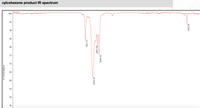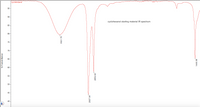
Chemistry
10th Edition
ISBN: 9781305957404
Author: Steven S. Zumdahl, Susan A. Zumdahl, Donald J. DeCoste
Publisher: Cengage Learning
expand_more
expand_more
format_list_bulleted
Question
What factors during the experiment caused the percent yield to be different than 100%? What impurities may be present in the final product (look at the spectroscopic data for evidence of this), and how does that effect the percent yield calculation?
I got 64% for the percent yield.

Transcribed Image Text:cylcohexene product IR spectrum
product
100-
95 -
90 -
85
80 -
75 -
70 -
65 -
60 -
55 -
50 -
45 -
% Transmittance
3021.57
2923.43
2857.93L
2836.42
1652.50

Transcribed Image Text:fcyclohexanol
95
90 -
cyclohexanol starting material IR spectrum
85 -
80
75 -
70 -
65 -
60 -
55
50
45 -
40 -
% Transmittance
3321.76
2927.04
2852.64
1449.38
Expert Solution
This question has been solved!
Explore an expertly crafted, step-by-step solution for a thorough understanding of key concepts.
This is a popular solution
Trending nowThis is a popular solution!
Step by stepSolved in 2 steps

Knowledge Booster
Learn more about
Need a deep-dive on the concept behind this application? Look no further. Learn more about this topic, chemistry and related others by exploring similar questions and additional content below.Similar questions
- An excess of sodium carbonate, Na2CO3, in solution is added to a solution containing 17.87 g CaCl2. After performing the experiment, 12.51 g of calcium carbonate, CaCO3, is produced. Calculate the percent yield of this reaction.arrow_forwardFor the following reaction, 5.86 grams of carbon tetrachloride are mixed with excess methane (CH4). The reaction yields 5.93 grams of dichloromethane (CH2CI2). What is the percent yield of this reaction? CH4 + CCh --> 2CH2Cl2 27.6% 109.1% 91.65% 84.5%arrow_forwardAccording to the following reaction, how many grams of hydrofluoric acid will be formed upon the complete reaction of 26.4 grams of water with excess silicon tetrafluoride? silicon tetrafluoride (s) + water (I) --> hydrofluoric acid (aq) + silicon dioxide (s) O58.6g O 2.9g O 14.7g 20.2garrow_forward
- What factors during the reducing bezil experiment caused the percent yield to be different than 100%? What impurities may be present in the final product and how does that effect the percent yield determination?arrow_forward2. Ethyl chloride is prepared by the reaction of chlorine with ethane according to the following equation: C:Ho(g) + Cl2(g) – CH$CI(g) + HCl(g) Ethane Ethyl chloride a) Write the balanced chemical equation. Show proof of completion. b) When 5.6 g of ethane is reacted with excess chlorine, determine its theoretical yield c) Calculate the percent yield of ethyl chloride if experimental results indicated that 8.54 g of ethyl chloride had formed.arrow_forwardConsider the reaction below. A student takes 53.12 grams of Fe and mixes it with 37.12 grams of S – then they heat the mixture to cause the reaction to occur. Use math and words to prove which of these reagents is the limiting reagent in that reaction.arrow_forward
- My theoretical yield of beryllium chloride was 12.4 grams. In an experiment, if my actual yield was 7.8 grams, what was my percent yield? Be + 2 HCl -----> BeCl2 + H2arrow_forwardSodium and chlorine react to form sodium chloride: What is the theoretical yield of sodium chloride for the reaction of 32.0 g Na with 107.2 g Cl2? A. 1.40 x 104 g NaCl B. 35.4 g NaCl C. 122 g NaCl D. 81.2 g NaClarrow_forwardfill in blanks and solve using the emthod shown! pleasearrow_forward
arrow_back_ios
arrow_forward_ios
Recommended textbooks for you
 ChemistryChemistryISBN:9781305957404Author:Steven S. Zumdahl, Susan A. Zumdahl, Donald J. DeCostePublisher:Cengage Learning
ChemistryChemistryISBN:9781305957404Author:Steven S. Zumdahl, Susan A. Zumdahl, Donald J. DeCostePublisher:Cengage Learning ChemistryChemistryISBN:9781259911156Author:Raymond Chang Dr., Jason Overby ProfessorPublisher:McGraw-Hill Education
ChemistryChemistryISBN:9781259911156Author:Raymond Chang Dr., Jason Overby ProfessorPublisher:McGraw-Hill Education Principles of Instrumental AnalysisChemistryISBN:9781305577213Author:Douglas A. Skoog, F. James Holler, Stanley R. CrouchPublisher:Cengage Learning
Principles of Instrumental AnalysisChemistryISBN:9781305577213Author:Douglas A. Skoog, F. James Holler, Stanley R. CrouchPublisher:Cengage Learning Organic ChemistryChemistryISBN:9780078021558Author:Janice Gorzynski Smith Dr.Publisher:McGraw-Hill Education
Organic ChemistryChemistryISBN:9780078021558Author:Janice Gorzynski Smith Dr.Publisher:McGraw-Hill Education Chemistry: Principles and ReactionsChemistryISBN:9781305079373Author:William L. Masterton, Cecile N. HurleyPublisher:Cengage Learning
Chemistry: Principles and ReactionsChemistryISBN:9781305079373Author:William L. Masterton, Cecile N. HurleyPublisher:Cengage Learning Elementary Principles of Chemical Processes, Bind...ChemistryISBN:9781118431221Author:Richard M. Felder, Ronald W. Rousseau, Lisa G. BullardPublisher:WILEY
Elementary Principles of Chemical Processes, Bind...ChemistryISBN:9781118431221Author:Richard M. Felder, Ronald W. Rousseau, Lisa G. BullardPublisher:WILEY

Chemistry
Chemistry
ISBN:9781305957404
Author:Steven S. Zumdahl, Susan A. Zumdahl, Donald J. DeCoste
Publisher:Cengage Learning

Chemistry
Chemistry
ISBN:9781259911156
Author:Raymond Chang Dr., Jason Overby Professor
Publisher:McGraw-Hill Education

Principles of Instrumental Analysis
Chemistry
ISBN:9781305577213
Author:Douglas A. Skoog, F. James Holler, Stanley R. Crouch
Publisher:Cengage Learning

Organic Chemistry
Chemistry
ISBN:9780078021558
Author:Janice Gorzynski Smith Dr.
Publisher:McGraw-Hill Education

Chemistry: Principles and Reactions
Chemistry
ISBN:9781305079373
Author:William L. Masterton, Cecile N. Hurley
Publisher:Cengage Learning

Elementary Principles of Chemical Processes, Bind...
Chemistry
ISBN:9781118431221
Author:Richard M. Felder, Ronald W. Rousseau, Lisa G. Bullard
Publisher:WILEY